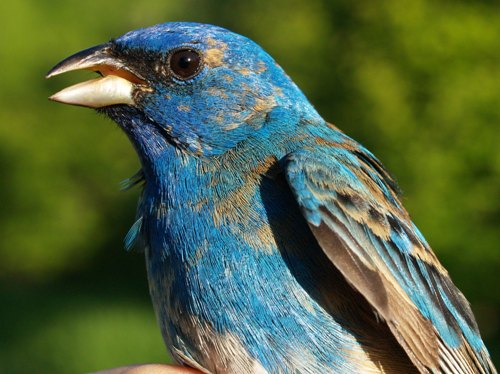|
|
THIS WEEK |
THIS SPRING |
2010 TOTAL |
SITE TOTAL |
|
# birds (and species) banded |
99 (26) |
596 (58) |
719 (60) |
24228 (105) |
|
# birds (and species) repeat |
35 (13) |
152 (26) |
182 (26) |
4523 (66) |
|
# birds (and species) return |
15 (8) |
110 (23) |
119 (25) |
739 (37) |
|
# species observed |
81 |
136 |
139 |
200 |
|
# net hours |
560.0 |
2959.4 |
2945.4 |
42932.6 |
|
# birds banded / 100 net hours |
17.7 |
20.1 |
23.8 |
56.4 |
|
|
Note: table does not include nocturnal banding (owls) |
Banders-in-charge: Simon Duval, Gay Gruner, Lance Laviolette
Assistants: Christine Barrie, Mike Beaupré, Christine Burt, Jean Demers, Andrée-Anne Deschamps, Philippe Dunn, Rejean Duval, Jeff Harrison, Malcolm Johnson, Vivek Kumar, Barbara MacDuff, Chris Murphy, Bronwyn Rayfield, Katie St-Jean, Bonnie Soutar, Clémence Soulard, Vince Spinelli.
Notes: In what has already been a somewhat quieter than usual spring, this week was the most disappointing of all. In past years, week 9 has typically shared the season peak with week 8; this year the number of birds and number of species banded were the lowest ever for this period. The number of species observed (81) was also a record low for week 9, which has ranged from 84 to 101 in past years. Overall, this week marked a continuation of the slow days at the end of last week, and probably much of this can be attributed to the continuing hot and muggy weather.
Despite the relatively low volume of migrants, we had several additions to the 2010 observations list, mostly typical late spring arrivals: Black-billed Cuckoo, Chimney Swift, Eastern Wood-Pewee, Traill's Flycatcher, Yellow-bellied Flycatcher, Swainson's Thrush, and Mourning Warbler. Four of these (Traill's Flycatcher, Yellow-bellied Flycatcher, Swainson's Thrush, and Mourning Warbler) we also banded for the first time this year, along with Great Crested Flycatcher.
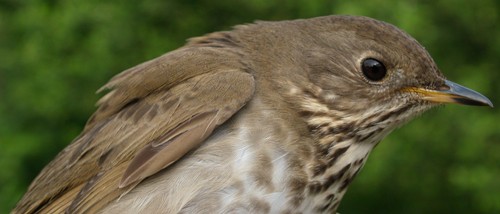
Thrushes come through MBO in small numbers in spring, but there are still good opportunities to compare species, such as the Grey-cheeked Thrush above and the Swainsons' Thrush below.
(Photos by Simon Duval)
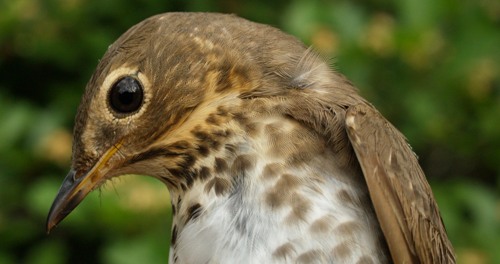
|
Cedar Waxwings accounted for nearly one quarter of all birds banded this week, the first time they have been this dominant in the nets in week 9, though they have topped the list 3 of the past 5 years in week 10 - another piece of evidence suggesting that migration was advanced this year. There were several new additions to the list of top species banded this week, including some of the late-season arrivals such as Traill's Flycatcher and Blackpoll Warbler. However, in this week last year we banded 25 Blackpolls (as well as 44 Tennessee Warblers), highlighting the differences from one year to another. In fact, the scarcity of warblers overall was the biggest change, with 7 species in the top 10 last year at this time, and just four this year (all tied for 6th place).
This week's
top 10 [last week's rank in brackets] |
#
individuals banded |
mean #
individuals observed daily |
1. Cedar Waxwing (23) [3] |
1. Cliff Swallow (33) [3] |
2. American Goldfinch (13) [-] |
2. Red-winged Blackbird (22) [2] |
3. Red-winged Blackbird (8) [1] |
3. Cedar Waxwing (16) [8] |
4. Baltimore Oriole (6) [6] |
4. American Crow (14) [6] |
5. Traill's Flycatcher (5) [-] |
5. Tree Swallow (14) [4] |
6. Gray Catbird (4) [-] |
6. American Goldfinch (11) [5] |
6. Yellow Warbler (4) [-] |
7. Ring-billed Gull (10) [1] |
6. Blackpoll Warbler (4) [-] |
8. Yellow Warbler (9) [7] |
6. Magnolia Warbler (4) [-] |
9. Mallard (8) [-] |
6. Common Yellowthroat (4) [2]
6. Song Sparrow (4) [-]
|
10. Baltimore Oriole (7) [-] |
|
In terms of species observed, Cliff Swallow and Red-winged Blackbird have remained around the top of the list for another week, while Ring-billed Gulls were surprisingly scarce this week compared to last (and also to other years, as Ring-billed Gull was the top species for week 9 on the list 3 of the past 5 spring seasons). Overall, the observed species also reflect an earlier than usual end to migration, with all ten species being local breeders rather than transients. We expect to see more of the same next week, which will be the end of our spring season for 2010.
|
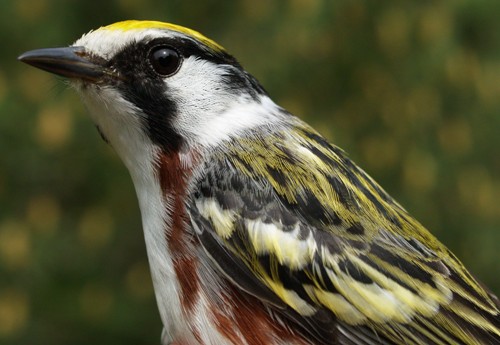
Although warbler diversity was lower than usual for this time of year, we still banded a few relatively uncommon species, including the Chestnut-sided Warbler above and the Mourning Warbler below.
(Photos by Simon Duval)
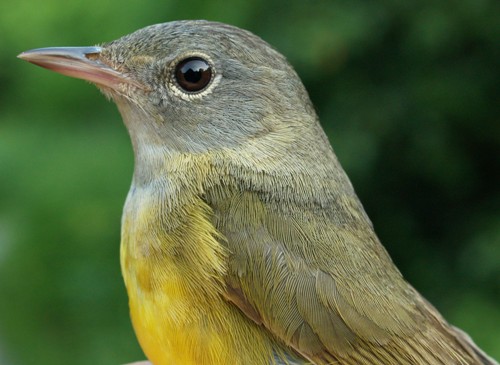
|

